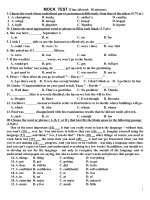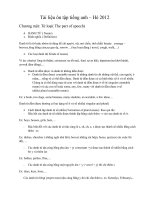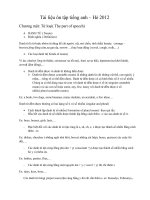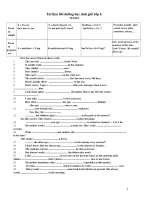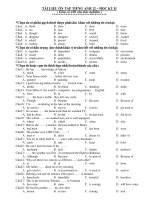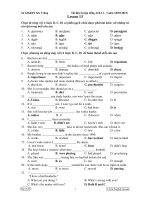Khối 5- Tài liệu ôn tập Tiếng Anh Tích hợp đợt 2
Bạn đang xem bản rút gọn của tài liệu. Xem và tải ngay bản đầy đủ của tài liệu tại đây (1.08 MB, 17 trang )
<span class='text_page_counter'>(1)</span><div class='page_container' data-page=1></div>
<span class='text_page_counter'>(2)</span><div class='page_container' data-page=2>
<b>Earth and Space</b>
1. How long does it take for the Earth to rotate one time?
24 hours
24 days
28 days
365 days
2. How long does it take the moon to orbit the Earth?
365 days
24 days
28 hours
28 days
3. Why does the Earth get night and day?
Because the moon orbits the Sun.
Because the moon is a light source.
Because the Earth rotates.
</div>
<span class='text_page_counter'>(3)</span><div class='page_container' data-page=3>
4. Here is a picture of a post and its shadow.
4a. Why does the post make a dark shadow?
Becauseit is opaque.
4b. During the day time shadows move and change size.
<b>Explain</b>why this happens.
</div>
<span class='text_page_counter'>(4)</span><div class='page_container' data-page=4>
5. Label with the words transparent, opaque and translucent.
6. Which of these is a source of light?
the moon
a star
a mirror
a cat’s eyes
7. Draw the reflected light rays.
transparent
translucent
opaque
</div>
<span class='text_page_counter'>(5)</span><div class='page_container' data-page=5>
8a. Draw light rays to show how Sarah sees the candle.
8b. Draw light rays to show how Sarah sees the cat.
9. Adam makes a shadow on the wall using his hands.
Adam moves his hands<b>further away</b>from the wall.
What will happen to the size of the shadow?
</div>
<span class='text_page_counter'>(6)</span><div class='page_container' data-page=6>
<b>Forces</b>
10. What is the unit of force?
metres
kilometres
kilograms
Newtons
11. What is the reading on this force meter?
Remember the correct units.
</div>
<span class='text_page_counter'>(7)</span><div class='page_container' data-page=7>
12. Some of the forces acting on this boat are shown by the arrows X, Y
and Z.
12a. What force is represented by force Y?
forward force
upthrust
air resistance
weight
12b. What force is represented by force Z?
upthrust
friction
weight
</div>
<span class='text_page_counter'>(8)</span><div class='page_container' data-page=8>
13. Which diagram shows a car slowing down?
14. Here is a picture of Isaac Newton.
Which force pulls the apple towards the Earth?
</div>
<span class='text_page_counter'>(9)</span><div class='page_container' data-page=9>
15. Daisy is investigating water resistance.
She makes five shapes out of clay and drops them in a thick liquid.
Daisy measures how long it takes for each shape to reach the bottom
of the container.
15a. What<b>variable</b>does Daisy change in her experiment?
The shape of the clay.
15b. Name one variable Daisy<b>controls</b>(keeps the same).
mass (kg) of the clay, the liquid amount and type, same container.
15c. Which shape will reach the bottom of the liquid quickest?
<b>Circle one</b>
<b>Explain</b>your answer from 15c.
</div>
<span class='text_page_counter'>(10)</span><div class='page_container' data-page=10>
<b>Digestion, Circulation and Respiration</b>
16. Label the body systems.
<b>digestive system</b> <b>circulatory system</b> <b>respiratory system</b>
<b>circulatory system</b>
<b>digestive system</b>
</div>
<span class='text_page_counter'>(11)</span><div class='page_container' data-page=11>
17. Which body part is in the circulatory system?
stomach
blood vessel
oesophagus
brain
18. Timmy does some exercise. What will happen to Timmy’s pulse rate
during exercise?
it will increase
it will decrease
it will stay the same
it will stop
19. Which organ is<b>not</b>in the digestive system?
oesophagus
small intestine
lungs
</div>
<span class='text_page_counter'>(12)</span><div class='page_container' data-page=12>
<b>Food Chains and Webs</b>
20. Look at the food chain and answer the questions.
20a. What is the<b>producer</b>in this food chain? corn
20b. What animals are<b>predators</b>? snake, owl
20c. What animal is<b>prey</b>of the snake? mouse
20d. Some animals become endangered because of hunting, over
fishing or pollution. What does<i><b>endangered</b></i>mean?
</div>
<span class='text_page_counter'>(13)</span><div class='page_container' data-page=13>
21. Look at the food web and answer the questions.
21a. Name one<b>herbivore</b>from the food web.
grasshopper or beetle
21b. Name the two<b>predators</b>of the beetles.
frog and mouse
21c. <b>Explain</b>what would happen to the food web if there is a drought
and all the grass dies.
</div>
<span class='text_page_counter'>(14)</span><div class='page_container' data-page=14>
<b>States of Matter</b>
22. Which substance will<b>not</b>dissolve in water?
pepper
sugar
baking soda
salt
23. Condensation is a change of state from...
gas to liquid.
liquid to solid.
liquid to gas.
gas to solid.
24. Which process is an example of a<b>irreversible change</b>?
dissolving salt
</div>
<span class='text_page_counter'>(15)</span><div class='page_container' data-page=15>
25. What is the melting point of ice and the freezing point of water?
100°c
0°c
1°c
-100°c
26. Which equipment is needed to separate rocks and sand?
a funnel
a magnet
a thermometer
a sieve
27. The picture shows Lucy separating sand from water.
What is this process called?
</div>
<span class='text_page_counter'>(16)</span><div class='page_container' data-page=16>
28. Ben is investigating how the number of stirs affects the time it takes
for a solid to dissolve.
He puts salt in a container and records how long it takes to dissolve.
He repeats the experiment, but changes the number of stirs.
Here are Ben’s results.
28a. What<b>variable</b>did Ben change in his investigation?
The number of stirs
28b. What did Ben<b>control</b>(keep the<i>same</i>)? Name one factor.
type and amount of water, type and amount of solid
28c. <b>Predict</b>the amount of seconds it would take with 20 stirs.
Anything less than 22 seconds
</div>
<span class='text_page_counter'>(17)</span><div class='page_container' data-page=17>
2e. Circle the correct words to make a conclusion for this experiment.
The <b>more / fewer</b> times a liquid is stirred, the
<b>quicker / slower</b> a solid will dissolve in it.
</div>
<!--links-->
